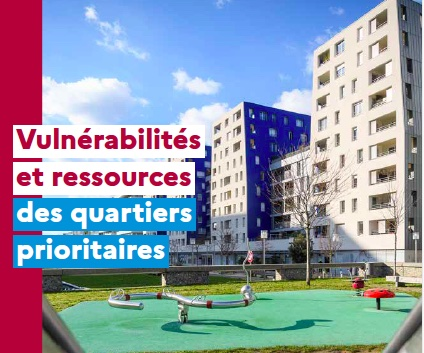"Nearly five and a half million people live in the 1,514 QPVs in metropolitan and overseas France. Residing more frequently in densely populated municipalities and in over-occupied housing, these inhabitants are also more vulnerable because of their employment conditions. They are the "newly vulnerable" of the health crisis.
The National Observatory of Urban Policies (ONPV) draws up, in its sixth reporta synthesis of various studies and surveys on the theme of vulnerabilities and resources in priority neighbourhoods of the city's policies.
The ONPV devotes a detailed chapter of the report to the digital practices of residents of priority neighborhoods.
It is based on the Capuni survey conducted in 2019 with 7500 people.
Researchers from the M@rsouin Scientific Interest Group compared the responses of residents of Priority Urban Neighborhoods (QPVs) with those of residents of Urban Aggregate Units** (metropolises and urban communities, in most cases) and those of the general population.
Less equipped with personal computers, smartphones or tablets...
In 2019, 87% of metropolitan QPV residents aged 18 to 59 had a smartphone (compared to 91% of residents in metropolitan France), 75% had a computer at home (compared to 89%) and 48% had a tablet (compared to 54%).
Référence :
Their reasons for not owning a smartphone are first of all the fact that they do not master this tool, then the cost of subscriptions.
... residents of the QPV use digital technology less for their daily activities
In 2019, 97% of residents of QPVs aged 18 to 59 used the Internet at least once in the past three months.
" While residents of QPVs aged 18-59 use the Internet as often as all residents of urban units encompassing a QPV to make a medical appointment, they use it less than residents of encompassing urban units to do their shopping online or to conduct banking transactions."
Only 39% of the residents of the QPVs concerned had already made a medical appointment via the Internet in the previous year, compared with 46% of those living in the surrounding urban units (UU). "Taking into consideration the control variables of the model, the visible difference between the two proportions is not due to the neighbourhood of residence but rather to the level of education and the socio-professional category of the individuals: the most qualified and the higher socio-professional categories being more disposed to this type of practice.
The M@rsoin team points to a greater difficulty felt by residents of these neighborhoods in using these specific digital platforms: 27% of residents of QPVs feel that using digital technology to do their shopping makes the task more difficult (compared to 13% of those in the surrounding UUs).
79% of residents of the QPV use the digital platforms offered by their bank, compared to 88% in the surrounding neighborhoods.
Only 15% of QPV residents shop online, compared to 25% in the surrounding UUs.
Fewer residents of the urban peripheral areas find it easy to do banking transactions online (79% versus 92%). " Beyond the effects of age, diploma, standard of living or possession of digital equipment giving access to the Internet, the inhabitants of the QPV have a 30% lower probability of turning to digital banking compared to the inhabitants of the surrounding UU.
Difficulties in completing administrative procedures online
14% of QPV residents find it difficult to apply for a benefit from the Caisse d'allocations familiales using digital technology (compared to 11% in the surrounding UUs).
The most significant difference concerns tax-related procedures: while 80% of residents in the surrounding UUs believe that it is "easy" to file taxes digitally, only 63% in the QPV share this sentiment.
22% of QPV residents find this online task difficult (12% in the encompassing UUs) and 15% find digital technology useless (8% in the encompassing UUs).
* The priority neighborhoods of the city policy (QPV) are defined according to a criterion of poverty of the inhabitants in urbanized areas. The inhabitants of these neighborhoods are characterized by their low standard of living as well as by a higher proportion of young people, unemployed people and immigrants.
** An encompassing urban unit is a territory of one or more municipalities with a continuous built-up area (no break of more than 200 meters between two buildings) and including at least one priority neighborhood. These urban units have at least 10,000 inhabitants.
The CAPUNI survey is supported by the National Agency for Territorial Cohesion (ANCT), the Brittany Region, and the Burgundy-Franche-Comté Region. It attempts to measure what digital technology brings (or does not bring) to individuals in terms ofempowerment. It aims to report on the uses, representations and power of action in terms of digital technology of the inhabitants of metropolitan France in 2019. Some specific territories have been studied through oversampling: isolated rural areas (municipalities far from major urban centers and low density, 1,500 questionnaires) and priority neighborhoods of the city policy (2,000 questionnaires). The CAPUNI survey was conducted by telephone from January 21 to June 17, 2019. 7,500 inhabitants of metropolitan France aged 18 and over responded.





